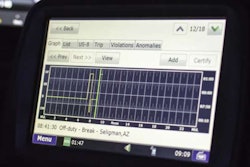
If you get stopped during the Commercial Vehicle Safety Alliance’s annual International Roadcheck June 5-7, you better be sure your hours-of-service — no matter how you record them or if you have any sort of exemption — are in order. That’s going to be the focus of the three-day enforcement blitz across North America.
During International Roadcheck, inspectors will primarily conduct the North American Standard Level I Inspection, a 37-step procedure that includes an examination of both driver operating requirements and vehicle mechanical fitness. But, with the federal electronic logging device mandate now in effect, law enforcement officers will be looking closely at drivers’ hours-of-service records too.
“The top reason drivers were placed out of service during 2017 International Roadcheck was for hours-of-service violations,” said CVSA President Capt. Christopher Turner of the Kansas Highway Patrol. “Thirty-two percent of drivers who were placed out of service during last year’s three-day International Roadcheck were removed from our roadways due to violations related to hours-of-service regulations. It’s definitely an area we need to call attention to this year.
“Although the electronic logging device rule that went into effect on Dec. 18 does not change any of the underlying hours-of-service rules or exceptions, the ELD mandate placed a spotlight on hours-of-service compliance. We thought this year would be a perfect opportunity to focus on the importance of the hours-of-service regulations.”
According to the CVSA, the vehicle inspection includes checking:
- brake systems
- cargo securement
- coupling devices
- driveline/driveshaft components
- exhaust systems
- frames
- fuel systems
- lighting devices
- steering mechanisms
- suspensions
- tires
- van and open-top trailer bodies
- wheels, rims and hubs
- windshield wipers.
Drivers will be asked to provide their operating credentials and hours-of-service documentation, and will be checked for seat belt usage. Inspectors will also be attentive to apparent alcohol and/or drug impairment, according to the CVSA.
If no critical inspection item violations are found during a Level I Inspection, a CVSA decal will be applied to the vehicle, indicating that the vehicle successfully passed a decal-eligible inspection conducted by a CVSA-certified inspector. If an inspector does identify critical inspection item violations, he or she may render the driver or vehicle out of service if the condition meets the North American Out-of-Service Criteria. This means the driver cannot operate the vehicle until the vehicle and/or driver qualification violation(s) are corrected.
CVSA has said in years past that an average of 15 trucks and buses are inspected every minute across North America during the 72-hour event. In last year’s Roadcheck, 15,000 out-of-service orders were issued. Of those, 12,000 were for vehicle-related violations and 3,000 were for driver-related violations. Violations related to hours of service and brakes topped the out-of-service infractions. Enforcers in 2017 conducted more than 63,o00 inspections during the 72-hour event.











